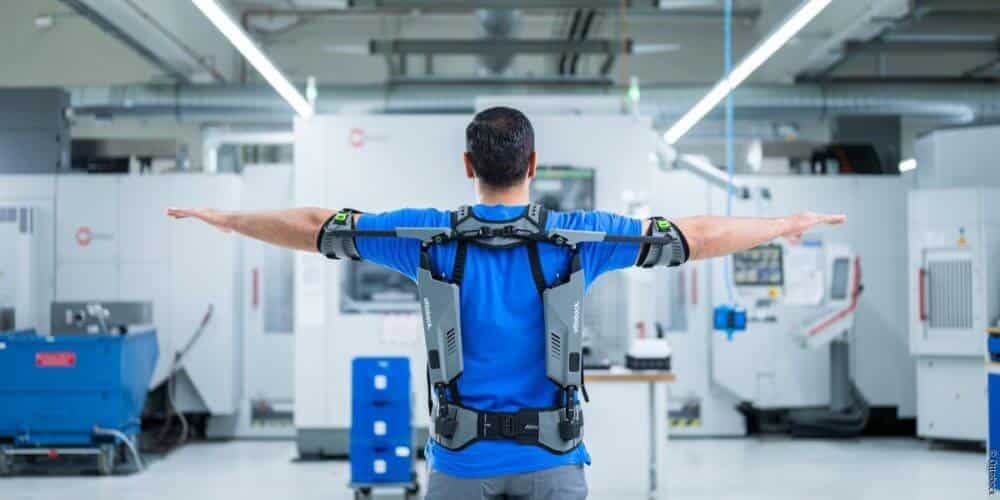Lifting boxes over the head, repositioning bedridden people, or assembling heavy components in manufacturing - many activities in working life require a monotonous posture or constant lifting. Exoskeletons can be used to prevent this from leading to tension and muscle and joint damage in the long term.
Exoskeletons relieve the body and help to perform certain movements without hindering the user. Up to now, they have been used primarily in industry and the skilled trades, but this is far from being the case across the board. The Ottobock company has established itself with the division Ottobock Bionic Exoskeletons specialises in the manufacture of exoskeletons for work activities. Dr. Sönke Rössing, CEO Ottobock Bionic Exoskeletons: "Our goal is to relieve people with physically demanding activities and create healthier workplaces. Our exoskeletons can reduce back pain, discomfort in the shoulders, neck, wrists or fingers. Such musculoskeletal disorders are the most common cause of sick days."
The possibilities for using exoskeletons are diverse and not limited to certain occupational sectors; they are gradually finding more and more areas of application. This is also partly due to the fact that not only the employees benefit from the application, but also the companies. Rössing describes which people exoskeletons could help: "All people who have to lift and carry heavy things or do a lot of overhead work in their daily working life. The areas of application for exoskeletons are very diverse, for example, when unloading containers, during painting and electrician work on ceilings, or during long operations to relieve surgeons*. Such physically demanding activities can be performed more comfortably with exoskeletons. They also have a positive effect on leisure time: since muscles and joints are less strained, users often no longer feel so exhausted in the evening."
As long as patients are still mobile and can help, it is easier for the nursing staff. It is difficult to help bedridden patients or people whose mobility is severely restricted, as they often have to be lifted and carried.
Exoskeletons help in the operating room
Users do not have to worry that the exoskeleton will become uncomfortable during use. This is because industrial exoskeletons for the field of prevention are considerably smaller than exoskeletons used in rehabilitation. The Ottobock Paexo Shoulder consists of connected individual parts that are put on and strapped down like a backpack and weighs just 1.9 kilograms. The model is available in sizes S to XXXL and can be adjusted to fit everyone.
The first models have already made it into the operating room to be Surgeons in their work. Even during long operations, for example in neurosurgery, doctors need to be able to treat the finest structures with precision at every step. A loss of hand strength or tension in the shoulder and neck area could have serious consequences for patients.
In addition, there are other areas of application in the field of healthcare facilities that unfortunately still receive far too little attention, for example nursing and care for the elderly. Here, too, exoskeletons could be helpful in relieving the workforce and reducing sick days. They would also be useful in home care, since relatives are also physically challenged by caregiving.
Focus area exoskeletons at REHACARE in hall 6
In order to further publicize the diverse application possibilities of exoskeletons, also in the field of prevention, there will be a larger area during REHACARE 2022 in Hall 6, which, in addition to presentations, will also offer the opportunity to experience exoskeletons in use. Initiator is Dr. Urs Schneider from the Fraunhofer Institute for Manufacturing Engineering and Automation IPA with the participation of the REHACARE trade fair, the University of Stuttgart IFF, the Wearable Robotics Association WEARRA as well as the inclusion offices LVR (Rhineland Regional Council) and FO (Landschaftsverband Westfalen-Lippe). In addition to the topic of prevention, the focus will also be on rehabilitation.
Urs Schneider: "Currently, trunk and shoulder exoskeletons are used in nursing for back relief and also already in the operating room for relief in cases of static forward lean. They relieve pressure on sensitive parts of the body that are known to hurt and wear out during activities. Passive exoskeletons provide resilient support and redirect forces to more stressed areas of the body, such as away from the lumbar spine to the thighs. Active exoskeletons even provide energy input with motor power. There are also full-body, elbow, wrist and thumb offloading systems."
In addition to prevention in physically healthy people, the focus during the trade show will also be on enabling people with disabilities to participate in the workplace through exoskeletons. Because here, too, the exoskeletons can be used preventively to avoid physical degradation: "Work-related industrial exoskeletons are used for damage prevention, i.e. for primary prevention. The following questions now arise. First, in the future, can exoskeletons also be used for back pain for secondary prevention? They are relatively harmless, but it affects many people. Second, can exoskeletons provide relief for physical disabilities in the future? In the case of wheelchair users, the focus must always be on the highly stressed shoulders. Can shoulder exoskeletons make life easier here in the future, for example in wheelchair-accessible assembly?" says Urs Schneider.
At this point, no one can say when exoskeletons will become the norm rather than the exception in the various professions. One thing is certain: they are often a great help to users, they contribute to employee satisfaction, and they often pay off for companies due to a reduction in absenteeism. We can therefore look forward to further developments in this area over the next few years.
Source: Prevention in the workplace: exoskeletons to protect against stress injuries (rehacare.de) (17.10.2022)
